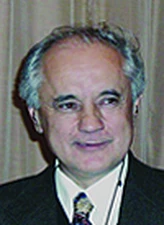Albert A. Galeev

The 2009 Hannes Alfvén Medal is awarded to Albert A. Galeev for his outstanding contributions to space plasma theory, including investigations of critical ionization phenomena, spontaneous reconnection and the theory of accretion disk corona.
Albert A. Galeev received his PhD degrees in Theoretical Physics from the Novosibirsk Institute of Nuclear Physics in Novosibirsk in 1964 and 1968. In 1973 he joined the Space Research Institute (IKI), where he served as the head of the Space Plasma Physics Department (1973-1988) and Director (1988-2002). Since 1992 he is a member of the Russian Academy of Sciences, and since 1985 a member of the International Academy of Astronautics. In 1990 A. Galeev was elected as member of the Academiae Europaeae, and in 1994 of the Max Plank Society. In 1993 A.A. Galeev received the title ‘de Docteur Honoris Causa L’Université de Paris-Sud’ and the von Karman Prize of the International Academy of Astronautics. In 1997 he received the Alexandre fon Humboldt award and in 2002 and 2005 the Russian President awards for outstanding achievements, promotion of international cooperation and his valuable contributions to space education in Russia.
At the early stage of his career, A. Galeev became one of the founders of a pioneering approach to the theory of weak turbulence in plasmas. Plasma description based on this theory for many decades served as an excellent tool for the solution of various problems both in laboratory and space plasmas. He immensely contributed to our understanding of spontaneous reconnection in planetary magnetospheres, solar flares and explosive processes accompanying the disc accretion in astrophysics. He developed a consistent theory of the ionization of a rarefied gas by magnetized plasma flowing with a velocity exceeding the critical value (Alfven phenomenon) which has an universal character and can be used for the explanation of the formation of the plasma torus of Io and the plasma tail of Titan, for different processes in cometary atmospheres and for the supernova remnants shocks.
A. Galeev has participated in many successful space missions, most notably the Venera-Halley project, where he was responsible for the entire plasma part. He played a key role in the Prognoz-8 and Intershock projects devoted to “in situ” investigations of collisionless shocks, and the Interball International Mission (1995-2002) for the study of mass and energy transfer in the Sun-Earth system. Prof. Galeev is an author or coauthor of nearly 300 refereed publications.
